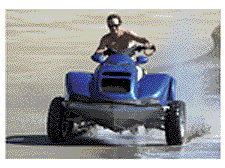
If you just look at the number of engines being built year after year – a steady downward trend – it may seem like there is no way to survive in this industry by building production automotive engines. However, most shops that are thriving have found something that gives them an edge. You have to be more specialized and more strategic in the markets you go after today. The powersports industry has been growing steadily in the last few years and may be worth a second look.
Powersports are fun, exciting and may remind you of vacation – but success in them is no day at the beach. The personal watercraft (PWC) and all-terrain vehicle (ATV) market segments require commitment and understanding to be successful in this niche market segment of the powersport industry, much like other niche markets we have highlighted in the past.
One of the keys to this market is to carve out your own area of the industry and put a stamp on it that is uniquely your own. For some shops, geographic location may play a role in your involvement; being located near a large body of water, for example, may help. For others, personal interest and previous participation may have ignited your passion and now you wish to take it to another, more profitable, level.
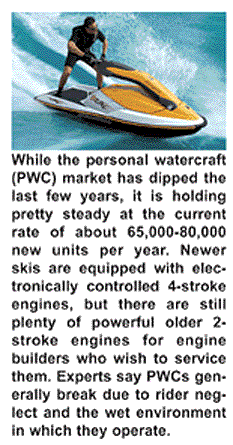
Both PWC and ATV markets fit squarely in the middle of the overall powersport segment, which also includes motorcycles and snowmobiles as well as small utility vehicles and outboard marine applications. The powersport segment is quite significant in size and scope but there are many nuances associated with each market segment that an ambitious engine builder will need to learn in order to find success. This begs the question: is it better to be an expert in one area or a generalist of many areas? While there is nothing wrong with having the ability to service anything that comes in the door, some shops prefer to concentrate on one area and be the best.
“Our primary business is the PWC and marine market,” says John Salvatore, PMC North America, Clearwater, FL. “The ATV market, however, is very new for us as we’ve just started to service this sector.”
While ATVs and PWCs may appear to have similar engines, the two are very different. According to experts, PWC engines are the most like snowmobile engines, which is why until recently PMCNA also served the sled market.
“ATVs and PWC engines are not similar at all, actually,” explains Salvatore. “ATVs have a transmission as part of the engine in most cases, but in a watercraft there isn’t a transmission. That makes the builds for these two engines completely different.”
According to Salvatore, the owner and or rider of the two machines are not the same guy either, but here the similarities switch. “Generally the ATV rider is more like a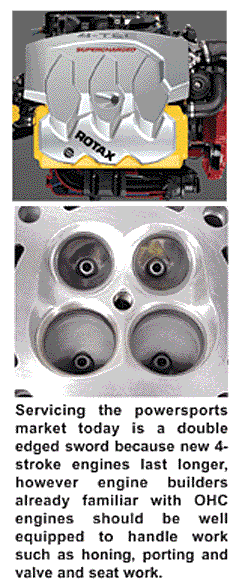
snowmobile guy – the person who owns it is the one who rides it. They usually do trail riding and take it long distances for camping, or whatever the case may be. Watercraft on the other hand is generally available to whoever happens to be standing next to it.
They’ll hop on and take it 100 yards offshore at wide-open throttle,” he says. “That’s not to say that people don’t ride the ATV around in their backyard in a circle or take the PWC on long runs, but as a general rule this is the way it breaks down. It’s a little different style of riding and a different customer.”
While the powersports industry overall is healthy, experts we spoke with say the PWC market has peaked in recent years. While PWC interest has seen a bit of a resurgence over the last year but it is unlikely to reach the levels it was in the mid-’90s when there were several manufacturers in the game reporting healthy sales. Today, there are very few manufacturers that have remained involved.
“Sea-Doo, Yamaha and Kawasaki are really the only players in PWCs right now,” says Salvatore. “Honda makes some, but not enough to put a hurt on anyone. They make a good ski but it’s not the best at anything, like Honda’s cars, some would argue, are. However, they are fantastically reliable.”
Experts point out that one of the reasons the PWC industry has been struggling is that most manufacturers switched from 2-stroke engines to more reliable 4-stroke engines.
“The PWC side of the market is much smaller and definitely more flat than the ATV market,” says Ralph Johnston, Wiseco Pistons, Mentor, OH. “We’ve been heavily impacted by the change from 2-stroke to 4-stroke engines in the PWC market. It’s still a nice market for us, but it’s not in a growth mode.”
Johnston says time simply marches on. “I think there are several things that have affected this market. PWC racing is not as strong as it once was in the ’80s and mid-’90s for one thing.”
Other factors experts believe have contributed to lower sales are concerns over the environment and the fact that there are fewer places to ride PWCs. Some lakes have banned PWCs because of the noisy, smoky 2-stroke engines still associated with these types of watercraft. Experts hope the newer 4-stroke engines, which burn cleaner and run quieter will lead to an industry comeback of sorts. However, 4-stroke engines don’t require as many rebuilds as the 2-stroke engines did. People aren’t upgrading performance as much as they once were.
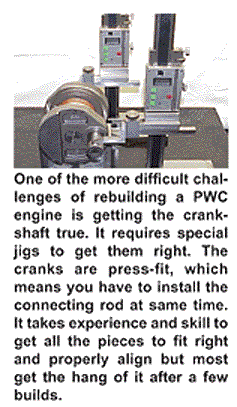
“I think the 4-stroke engines will bring about a different type of market and different failures,” Salvatore explains. “I don’t think you’ll see the catastrophic rod through the block failure that we see with 2-stroke engines, or melted pistons. On the wear side of the equation, 2-stroke engines don’t wear out either. I haven’t seen a worn out 2-stroke engine since I’ve worked here.”
Experts say that when 2-stroke engines fail it’s usually related to fuel or carburetion problems. The newer stuff is fuel-injected, however, so you don’t see those kinds of issues very often.
A large portion of the watercraft population is hanging on boat-lifts behind homes on inland lakes. The percentage of PWCs that are ridden in big water (oceans) is less than what are ridden on inland lakes around the country, say experts, so geographic location may not be as much of an issue as one would think.
Because manufacturers have added extended warranties to try and entice new buyers Salvatore says he rarely gets any calls on the newer watercraft. “The majority of our customers have equipment from about ’96 or ’97 to 2002, which is basically the peak of the watercraft industry.”
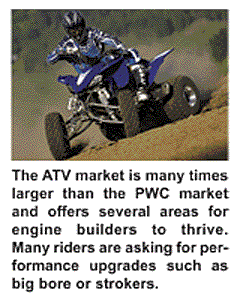
There were many PWCs built in the late ’80s and early ’90s but no one is fixing those anymore. It quickly becomes not cost effective to put a $1,000 engine in a ski that’s only worth that much.
Still, there are plenty of 2-strokes out there that are ripe for potential rebuilds. “We get more calls on the bigger, more powerful engines,” says Salvatore. “Sea-Doo has a 135 hp 951 cc motor that was their big gun 2-stroke motor that generates a lot of work for us. Yamaha builds a 3-cylinder 1200 cc 155 hp motor that we get a lot of calls about. I think that it’s just by design, though, that we get these kinds of inquiries. These are the ones that people do all sorts of modifications to and subsequently they’re probably pushed more to the edge of the design.”
ATV Interest Up
“We’ve seen a reasonably steady decline (of PWC rebuilds) in the last couple of years,” says PMCNA’s Salvatore. “The older stuff people aren’t fixing as much anymore and the newer stuff isn’t breaking as often. So you shrink to certain level. We have to be smarter about how we run the business, what we’re going to try to market and sell. That’s why we’re expanding toward the ATV market now.”
The ATV market is much larger than the PWC market, says Salvatore. “The statistics I’ve seen from 2005 said there were 67,000 new PWC sold as compared to 895,000 ATVs that year.”
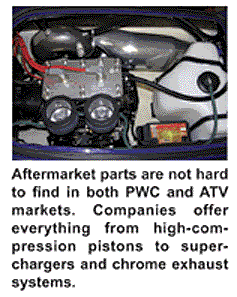
ATVs don’t have the same types of failures or as often, say experts. The failure rate with PWCs is greater because of their environment coupled with abuse or neglect. Also, the ATV owner is more likely to work on his own equipment, which means if it breaks he’s often going to do the repairs himself.
Salvatore says ATV DIYers don’t necessarily take away from the market because they aren’t doing complete engine rebuilds in most cases. However, he says they’re a little more hands on and less likely to break their engines than a PWC owner.
“Normally, because of the plated cylinder bores, what guys are asking for first is a high-compression piston,” says Wiseco’s Johnston. “That’s usually the first replacement, but there is also a portion of the market that wants to upgrade to a big-bore application. And they’ll put in new liners or sleeves and then over-bore them between 2 mm and 4 mm, in certain applications. Johnston says the majority of powersport cylinders are plated, which means any boring or honing operation will have to be followed up by sending the cylinder out for replating.
Currently Wiseco offers the pistons and top and bottom end gasket kits for many of the powersport (ATV/PWC) applications, and it has a new product called the “PK” series, which includes a piston and top end gasket kit.
Johnston says there are some specialty shops building big bore engines for several ATV applications. “One such company is Thumper Racing out of Texas, they do stroker motors and big bores. They are catering to the higher end of the market; people who are putting $3,000-$4,000 into the engine,” says Johnston.
The most popular ATV engines are probably in the 700cc range, but all the racing engines are 450cc because the rules stipulate that size. Yamaha has a popular sport-quad, called the Raptor, which is 700cc. Kawasaki has a new 800cc and Polaris also has a new one. So there is a distinct difference between the sport models and race models.
“Racers may rebuild their engines more often than sport riders, but you don’t want to discount the sport rider who’s building 700 cc dune-quads,” cautions Johnston. “These customers overall are spending more than the racers because they are tricking every part of the engine and machine with chrome parts and other performance accessories. The racers probably go through more hard parts though.
“There are a lot of people doing headwork with the 4-stroke ATV engines, and a lot of the powersports guys aren’t as equipped to build engines with valve and seat type work,” Johnston notes. “More ATV people are asking for performance builds so there’s definitely an opportunity for builders to do this type of work.”
“Many of the people we deal with have carved their own niche out and cater to either the high end or the middle of these markets. There are many different areas in each of these niche markets that can be a good opportunity for the right shop. And some of the shops we’ve seen have carved their niche by making parts and pieces just for one specific area of the market. For example, we’ve got some guys who only build vintage motorcycle engines.
With the manufacturers heavily pursuing 4-stroke engine designs for their new watercraft and ATVs, engine builders may find themselves in a unique position to benefit from the changing tide. Many automotive engine builders already have the necessary equipment to service these engines, which typically have multi-valve OHC cylinder heads. A single cylinder OHC engine should be relatively easy to setup for service and require very little investment in new tooling. Experts agree that engine builders who can work on these cylinder heads, providing valve jobs as well as porting and honing services will have a big advantage in the market when it comes to working on these engines.













